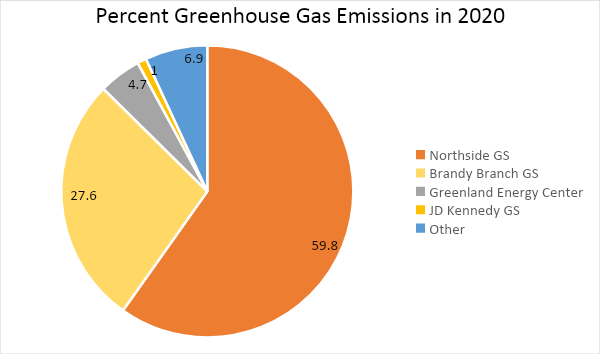Jacksonville Electric Authority
Photo by SCNEF
Since its inception, the Jacksonville Electric Authority (JEA) has been charged with delivering reliable and affordable electricity throughout its service area. It has fulfilled that charge and its citizen owners have been placated. As a consequence, JEA has been given a degree of autonomy with limited scrutiny and has largely maintained the status quo. Renewable energy comprised 1.5% of JEA’s energy generation portfolio 2022 and it is heavily reliant on a coal-fired generating station for energy generation. Conversely, other municipal utilities have begun transitioning their energy generation from highly polluting fossil fuels to cleaner fuel options and renewable energy.
JEA Plans for the Future
The Sierra Club reviewed and rated the long-term plans for utilities nation-wide based on their “plans to retire coal, construct new gas plants, and build new clean energy”. In the 2021 and 2022 ratings JEA’s plans were among the lowest scoring plans. As a result, JEA received an F grade in 2021 and a D grade in 2022 for its failure to set a timeline for retiring its coal plants and transition to clean energy sources. By contrast, the Orlando Utilities Commission’s plans received a B grade in the 2021 and 2022 reviews illustrating a utility company can modernize its energy portfolio if there is a will to do so. Links to the aforementioned review and recent reports are provided below.
The Dirty Truth About Utilities and Climate Pledges
JEA and Greenhouse Gas Emissions
With the exception of emissions by automobiles, trucks, and transportation systems, JEA facilities are the primary source of greenhouse gas (GHG) emissions in Northeast Florida. An analysis of EPA emissions data by the Sierra Club of Northeast Florida (SCNEF) revealed JEA is the source of over 90% of the annual GHG emissions by large facilities in the region. The analysis also revealed some areas of the city received disproportionate, direct exposure to JEA GHG emissions. The analysis illustrates the magnitude of annual JEA GHG emissions is substantial and a major contributor to global warming. Use the link below to obtain the SCNEF Greenhouse Gas Emissions report.
Sierra Club of Northeast Florida Greenhouse Gas Emissions Report
Northside Generating Station
The aforementioned greenhouse gas (GHG) emissions analysis revealed the primary source of JEA GHG emissions have been, and continue to be, coal-fired power plants. From 2011 to 2018 the St Johns River and Northside Generating Stations accounted for 73 to 83 percent of the annual GHG emission in Duval County. After the St. Johns River Power Generating Station was decommissioned in 2017 the Northside Generating Station (NSGS) accounted for 60% of the annual GHG emissions. The NSGS’s two coal-fired generating stations, Units 1 and 2, were built in 1966 and 1972, respectively. The technology employed by these units is dated and inefficient by modern standards. The pollution mitigation systems used with the NSGS generating units meet minimal EPA requirements for reducing atmospheric pollutants. Further, the generating station is located in an environmentally sensitive area which exposes surrounding wetlands to harm from coal ash and liquid waste. JEA currently has no timeline for decommissioning and replacing the NSGS.

JEA and Renewable Energy
While many other municipal utilities made substantial commitments to renewable energy, JEA derived 1.5% of its energy from renewable sources in 2022. To put this into context, twelve mid to large Florida cities and their associated utilities have committed to derive 100% of their energy from renewable sources by or before 2050.
Photo by SCNEF
JEA Oversight and Management
For decades JEA was led by administrators committed to deliver reliable, affordable electricity and little else. In recent years it was led by administrators who advocated for its sale to a private energy company. JEA was portrayed as a failing utility lacking financial viability and unable to innovate its way to success. Regardless, JEA remains a citizen-owned utility, has new leadership, and a directive to succeed. Will the citizen-owners, and the leaders who represent them, encourage JEA to expand its original charge beyond merely delivering cheap electricity? Will there be support for innovation, modernization, and efforts to capitalize on cost-effective renewable energy options? Will there be support for reducing Jacksonville’s carbon footprint, operating in a socially responsible fashion, and adopting practices that help address longstanding environmental justice issues? These questions need to be answered in an affirmative fashion soon to help stem the increase in global warming.
